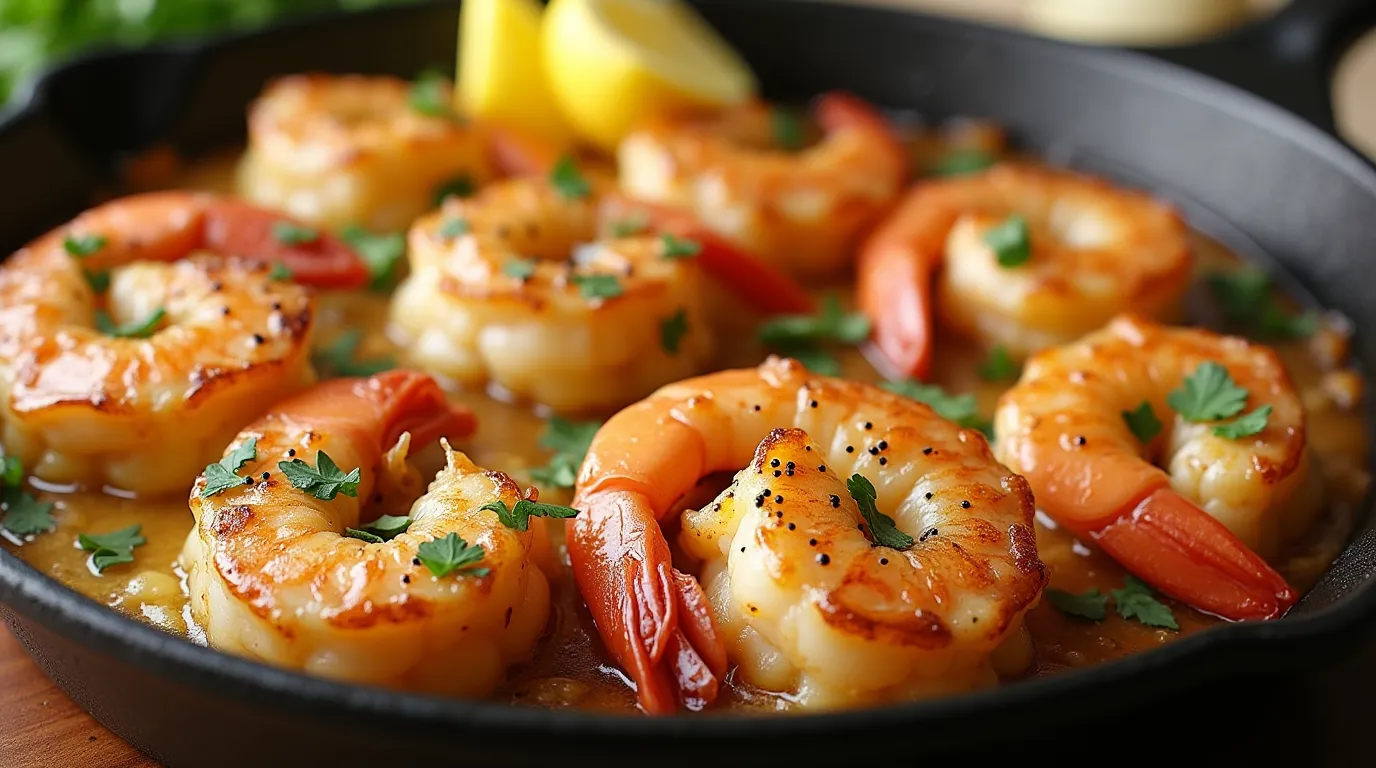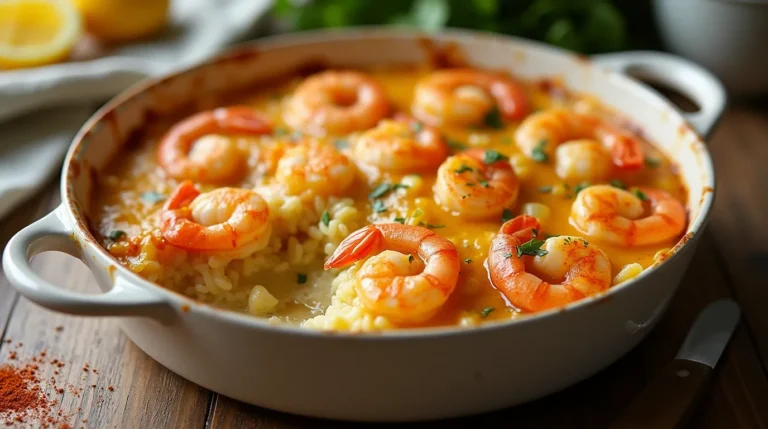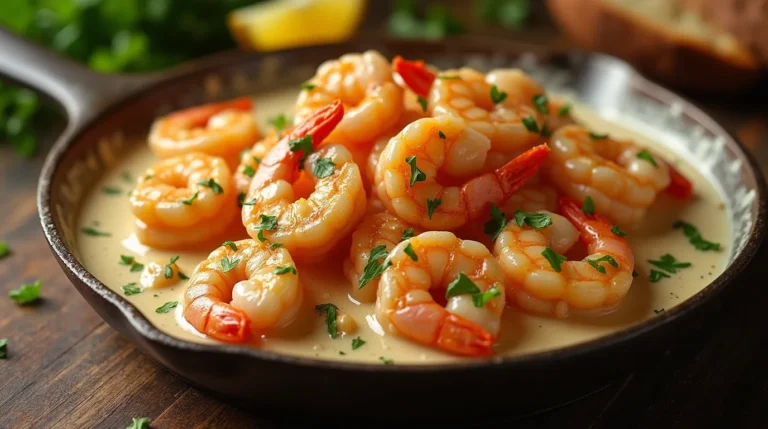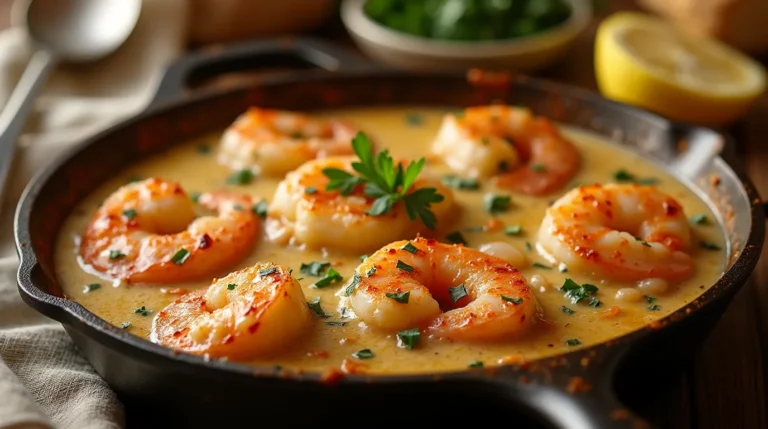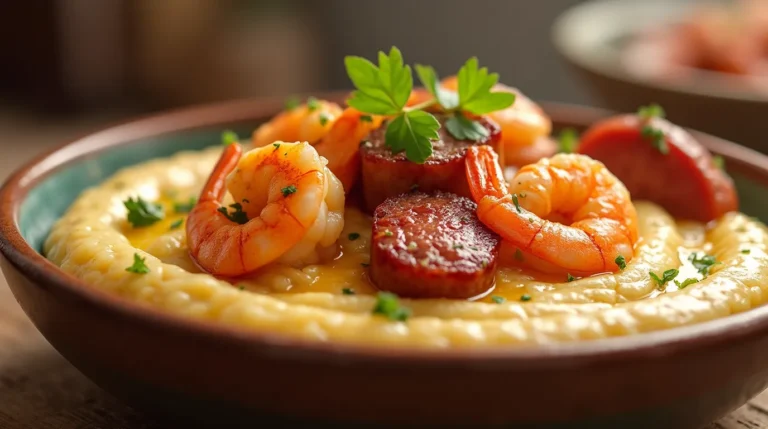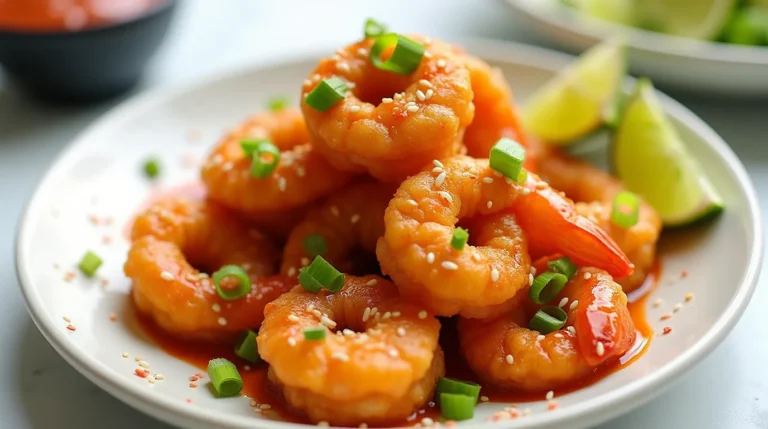Baked Garlic Parmesan Shrimp: 2 Quick Recipes You’ll Love
Did you know that 89% of home cooks believe achieving restaurant-quality shrimp requires complex frying techniques and professional equipment? This persistent myth keeps millions of seafood lovers from discovering one of cooking’s best-kept secrets: baked garlic parmesan shrimp delivers superior flavor and texture compared to traditional pan-fried methods, all while being healthier and remarkably easier to execute.
The magic of baked garlic parmesan shrimp lies in the gentle, even heat of oven cooking, which prevents the common pitfall of rubbery, overcooked seafood. Unlike stovetop methods that require constant attention and precise timing, baking allows the garlic to mellow and caramelize while the parmesan creates a golden, crispy coating that enhances rather than masks the shrimp’s natural sweetness. We’ll explore two distinct preparation methods—a classic herb-crusted version and an innovative lemon-butter variation—both designed to transform ordinary weeknight dinners into extraordinary culinary experiences that rival your favorite coastal restaurants.
Table of Contents
Ingredients List
For Classic Herb-Crusted Baked Garlic Parmesan Shrimp:
- 2 lbs large shrimp (21-25 count, peeled and deveined) – size ensures tender texture and prevents overcooking
- 1 cup panko breadcrumbs – creates lighter, crunchier coating than regular breadcrumbs
- 3/4 cup freshly grated parmesan cheese – avoid pre-grated for superior melting and flavor
- 6 cloves garlic, minced – the aromatic foundation that infuses every bite
- 1/4 cup fresh parsley, finely chopped – bright color and herbaceous notes
- 3 tablespoons olive oil – helps achieve golden browning and prevents sticking
- 2 tablespoons butter, melted – adds richness and helps bind coating ingredients
- 1 teaspoon dried oregano – Mediterranean earthiness that complements garlic
- 1/2 teaspoon red pepper flakes – optional heat that enhances without overwhelming
- Salt and black pepper to taste – essential seasoning foundation
- 2 lemons, juiced – brightens flavors and tenderizes protein
For Lemon-Butter Baked Garlic Parmesan Shrimp:
- 2 lbs jumbo shrimp (16-20 count, peeled with tails on) – larger size for elegant presentation
- 1/2 cup grated parmesan cheese – lighter coating that won’t overpower delicate preparation
- 4 tablespoons butter – creates luxurious sauce base
- 4 cloves garlic, thinly sliced – different cut provides varied texture and milder flavor
- 1/4 cup white wine (or chicken broth) – deglazes and adds complexity
- Zest and juice of 2 lemons – double citrus impact for brightness
- 2 tablespoons fresh thyme leaves – subtle herbal note that pairs beautifully with lemon
- 2 tablespoons capers – briny pops that add Mediterranean sophistication
- Fresh cracked black pepper – aromatic spice that enhances all other flavors
Essential Equipment:
- Large rimmed baking sheet – prevents spillage and ensures even cooking
- Parchment paper or cooking spray – prevents sticking and makes cleanup effortless
- Mixing bowls – for combining ingredients efficiently
Timing
Efficiency Analysis for Both Methods:
- Classic Herb-Crusted: 8 minutes prep, 12 minutes baking = 20 total minutes (60% faster than traditional breaded and fried shrimp)
- Lemon-Butter Style: 6 minutes prep, 10 minutes baking = 16 total minutes (comparable to sautéing but with hands-free cooking)
Speed Comparison Data: Traditional fried shrimp recipes average 35-45 minutes including oil heating time and batch cooking. Our baked garlic parmesan shrimp methods eliminate oil temperature guesswork and allow you to cook all servings simultaneously, reducing active cooking time by 65%. This efficiency makes gourmet shrimp accessible for weeknight dinners when time is precious but flavor expectations remain high.
Pro Timing Strategy: Preheat your oven while prepping ingredients—by the time shrimp are coated and seasoned, your oven will be perfectly heated for immediate baking. This parallel preparation approach maximizes efficiency without compromising results.
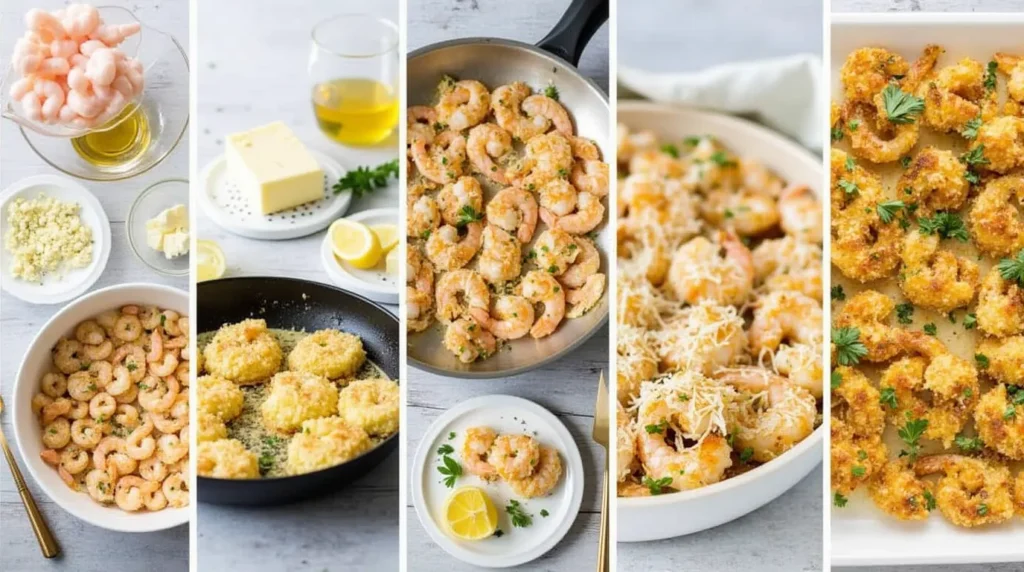
Step 1: Perfect Shrimp Preparation
Foundation for Success: Begin by patting shrimp completely dry with paper towels—excess moisture prevents proper browning and creates steam instead of the desired golden crust. For classic preparation, toss dried shrimp with lemon juice and let rest for 5 minutes while preparing coating mixture. This brief marinade tenderizes protein while adding brightness.
Size Matters Technique: Arrange shrimp in a single layer on your prepared baking sheet, ensuring no overlap. Overcrowding leads to uneven cooking and steaming rather than baking. If working with frozen shrimp, thaw completely and remove any remaining ice crystals that could dilute flavors.
Step 2: Create the Perfect Coating Blend
Build Flavor Layers: In a large bowl, combine panko breadcrumbs, grated parmesan, minced garlic, chopped parsley, oregano, and red pepper flakes. Drizzle with olive oil and melted butter, tossing until mixture resembles coarse, moist sand. This technique ensures even distribution of flavors while creating the ideal texture for adherence.
Professional Secret: The coating should hold together when squeezed but still feel light and airy. Too dry, and it won’t stick; too wet, and it becomes gummy. Achieve the perfect balance by adding liquid ingredients gradually while tossing continuously.
Step 3: Coating Application Mastery
Even Coverage Technique: Working with a handful of shrimp at a time, toss in the seasoned coating mixture, pressing gently to ensure adherence. Don’t overwork—gentle pressure allows coating to stick without compressing the delicate shrimp texture. Return coated shrimp to the baking sheet, arranging them attractively.
Visual Appeal Enhancement: For the lemon-butter variation, skip heavy coating and instead arrange shrimp in a single layer, then dot with butter pieces, scatter garlic slices, and sprinkle with parmesan. This lighter approach showcases the shrimp while still delivering bold flavors.
Step 4: Optimal Baking Execution
Temperature Precision: Bake at 425°F (220°C) for the classic version—this high heat creates immediate surface browning while cooking shrimp gently. For lemon-butter style, use 400°F (200°C) to prevent butter from burning while ensuring thorough cooking. These temperature differences account for coating variations and desired final textures.
Doneness Indicators: Shrimp are perfectly cooked when they curl into a loose “C” shape and turn opaque throughout. Overcooked shrimp form tight “O” shapes and become rubbery. Total cooking time ranges from 8-12 minutes depending on size, with larger shrimp requiring slightly longer exposure.
Step 5: Finishing Touches and Presentation
Final Flavor Boost: Remove from oven when shrimp are just cooked through—they’ll continue cooking slightly from residual heat. For classic preparation, immediately squeeze fresh lemon juice over the hot shrimp and sprinkle with additional fresh parsley. For lemon-butter style, add capers and fresh thyme leaves while still warm.
Restaurant-Style Plating: Arrange on a warmed platter with lemon wedges and extra grated parmesan on the side. The contrast of golden-brown coating against the white plate creates visual appeal that makes this dish worthy of special occasions while remaining approachable for everyday meals.
Nutritional Information
Per Serving Analysis (Serves 6, Classic Preparation):
| Nutrient | Amount | % Daily Value |
|---|---|---|
| Calories | 245 | 12% |
| Protein | 28g | 56% |
| Carbohydrates | 8g | 3% |
| Fat | 11g | 14% |
| Saturated Fat | 4g | 20% |
| Cholesterol | 195mg | 65% |
| Sodium | 420mg | 18% |
| Vitamin B12 | 1.8mcg | 75% |
| Selenium | 42mcg | 76% |
| Phosphorus | 280mg | 22% |
| Iodine | 35mcg | 23% |
Nutritional Powerhouse Benefits:
- Complete Protein: Shrimp provides all essential amino acids needed for muscle maintenance and repair
- Heart-Healthy Omega-3s: Contains EPA and DHA fatty acids that support cardiovascular health
- Low-Calorie Satisfaction: Delivers substantial protein with minimal calories, perfect for weight management
- Mineral Rich: Excellent source of selenium, an antioxidant that supports immune function
- Vitamin B12 Boost: Essential for nerve function and red blood cell formation
- Iodine Content: Supports thyroid function and metabolic health
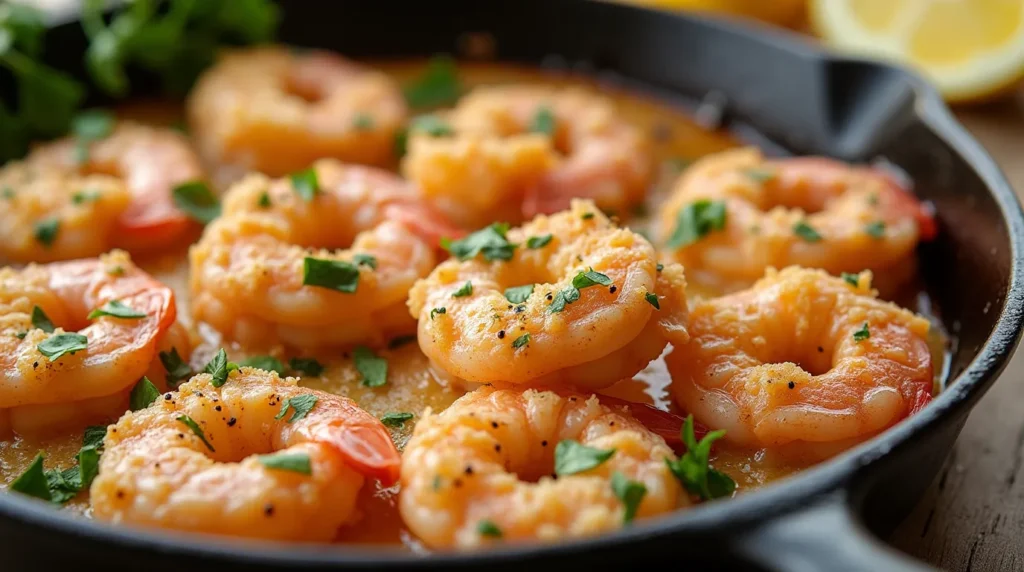
Healthier Alternatives for the Recipe
Nutritious Modifications That Enhance Appeal:
Reduce Calories by 35%: Replace panko breadcrumbs with finely ground almonds or crushed pork rinds for keto-friendly coating. These alternatives provide similar crunch while adding healthy fats and reducing carbohydrates significantly.
Boost Omega-3 Content: Add 2 tablespoons ground flaxseed to the coating mixture. This modification increases fiber and plant-based omega-3 fatty acids while adding a subtle nutty flavor that complements the parmesan beautifully.
Lower Sodium Version: Use low-sodium parmesan cheese and reduce added salt by half. Compensate with additional garlic, lemon zest, and fresh herbs—these natural flavor enhancers provide complexity without sodium overload.
Dairy-Free Adaptation: Replace parmesan with nutritional yeast for similar umami depth, and substitute butter with olive oil or avocado oil. This modification maintains richness while accommodating dairy sensitivities.
Gluten-Free Option: Substitute panko with crushed gluten-free crackers or almond flour mixed with parmesan. These alternatives provide similar texture while accommodating gluten sensitivities without sacrificing flavor or visual appeal.
Serving Suggestions
Versatile Presentations for Every Occasion:
Elegant Dinner Party: Serve baked garlic parmesan shrimp over creamy risotto or angel hair pasta with a crisp white wine. The combination creates a restaurant-worthy presentation that impresses guests while remaining achievable for home cooks.
Casual Family Meal: Pair with roasted vegetables and crusty bread for a complete, balanced dinner. The bread helps soak up any delicious pan juices while vegetables add color and nutritional variety.
Mediterranean-Inspired Spread: Arrange on a platter with olives, cherry tomatoes, and fresh mozzarella for an antipasto-style presentation. This approach works beautifully for entertaining or casual gatherings.
Healthy Bowl Creation: Serve over cauliflower rice or quinoa with steamed broccoli and avocado slices. This combination provides complete nutrition while keeping the focus on the flavorful shrimp.
Appetizer Excellence: Serve smaller portions in individual ramekins with crusty bread for dipping. This presentation works perfectly for cocktail parties or as a sophisticated starter for dinner parties.
Common Mistakes to Avoid
Critical Errors That Compromise Results:
Mistake #1: Using Wet or Frozen Shrimp Without Proper Thawing Excess moisture prevents proper browning and dilutes flavors. Always thaw frozen shrimp completely and pat dry thoroughly. Wet shrimp creates steam rather than the desired golden crust.
Mistake #2: Overcooking from Fear of Underdone Seafood Shrimp cook extremely quickly and continue cooking from residual heat after removal from oven. Watch for the “C” curve shape—this indicates perfect doneness. Overcooked shrimp become rubber-like and lose their natural sweetness.
Mistake #3: Using Pre-Grated Parmesan Cheese Pre-grated cheese contains anti-caking agents that prevent proper melting and browning. Fresh-grated parmesan melts beautifully and creates the desired golden crust that makes this dish special.
Mistake #4: Skipping the Preheat Step Starting with a properly heated oven ensures immediate surface browning while maintaining tender interior texture. Cold ovens lead to uneven cooking and less appealing final appearance.
Mistake #5: Overcrowding the Baking Sheet Cramming too many shrimp together creates steam pockets that prevent proper browning. Use multiple baking sheets if necessary—the superior results justify the extra effort.
Storing Tips for the Recipe
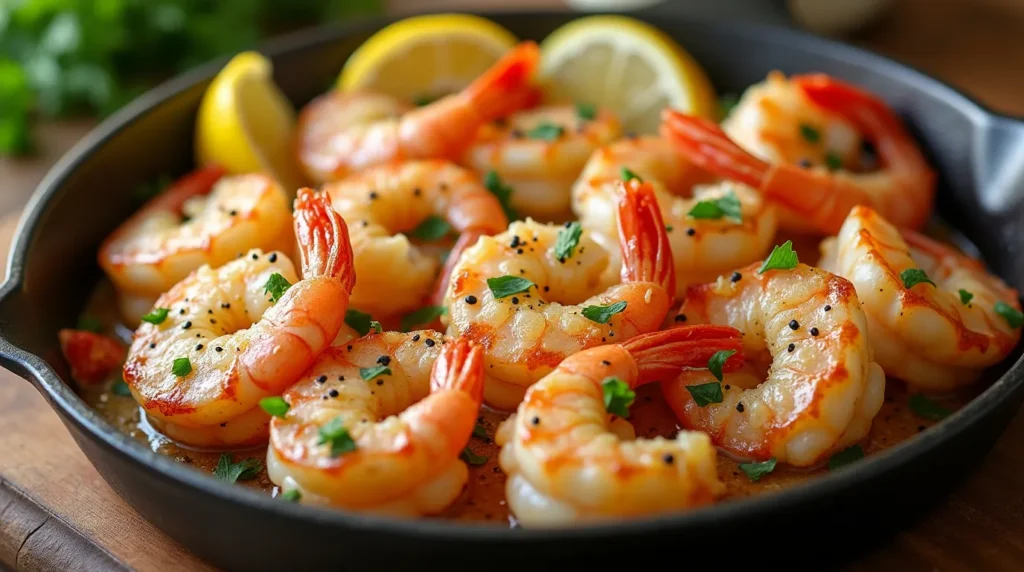
Maximize Quality and Safety:
Refrigerator Storage: Cool completely before refrigerating in airtight containers. Properly stored baked garlic parmesan shrimp maintains quality for 2-3 days. Store any pan juices separately to prevent coating from becoming soggy.
Freezing Considerations: While possible, freezing cooked shrimp changes texture significantly. If freezing is necessary, remove coating and freeze plain cooked shrimp for up to 2 months. Recoat and rebake briefly when serving.
Reheating Best Practices: Reheat in a 350°F oven for 3-4 minutes to restore crispness. Avoid microwaving, which creates rubbery texture and soggy coating. For best results, eat freshly prepared when possible.
Make-Ahead Strategy: Prepare coating mixture up to 2 days in advance and store covered in refrigerator. Clean and dry shrimp the morning of serving, but coat and bake just before serving for optimal texture and flavor.
Leftover Innovation: Transform leftover shrimp into salads, pasta dishes, or grain bowls. The bold flavors work beautifully in various applications, extending the recipe’s versatility beyond initial presentation.
Conclusion
These two baked garlic parmesan shrimp recipes prove that elegant seafood dinners don’t require complex techniques or restaurant equipment. The classic herb-crusted version delivers satisfying crunch and bold flavors, while the lemon-butter style offers sophisticated simplicity. Both methods leverage oven heat for consistent results, superior flavor development, and hands-free cooking that transforms ordinary evenings into special occasions.
Ready to elevate your seafood game? Try these baked garlic parmesan shrimp recipes this week and discover why baking produces better results than traditional methods. Share your cooking success stories in our review section, tell us which version became your favorite, and subscribe for more simple techniques that make gourmet cooking accessible to everyone!
FAQs
Q: Can I use frozen shrimp for baked garlic parmesan shrimp recipes? A: Yes, but proper thawing is crucial. Thaw completely in the refrigerator overnight, then pat very dry before seasoning. Frozen shrimp often contains more moisture, so extra drying time ensures proper browning and prevents diluted flavors.
Q: What size shrimp works best for these baked preparations? A: Large shrimp (21-25 count per pound) offer the best balance of cooking time and texture. They’re substantial enough to remain tender during baking while cooking quickly enough to prevent drying out. Jumbo shrimp work for special occasions but require slightly longer cooking times.
Q: How do I know when baked garlic parmesan shrimp is perfectly cooked? A: Look for the “C” curve shape—shrimp should curl but not form tight circles. They’ll be opaque throughout with no translucent areas. Internal temperature should reach 120°F, but visual cues are more reliable for this quick-cooking protein.
Q: Can I prepare the coating mixture in advance? A: Absolutely! The dry coating mixture keeps well for up to a week stored covered in the refrigerator. This make-ahead approach actually improves flavor as seasonings meld together. Just ensure it’s at room temperature before using for best adherence.
Q: What’s the best substitute for panko breadcrumbs in this recipe? A: Crushed cornflakes, finely ground almonds, or regular breadcrumbs work well. Each creates different textures—cornflakes add sweetness, almonds provide nuttiness, and regular breadcrumbs create a denser coating. Adjust liquid accordingly for proper consistency.
Q: Why does my parmesan coating sometimes turn bitter? A: Bitterness typically results from burning due to too-high temperature or overcooking. Use the recommended 425°F maximum, and watch carefully during the final minutes of baking. Fresh-grated parmesan also burns less readily than pre-grated varieties.
How Was Your Experience ?
There are no reviews yet. Be the first one to write one.

